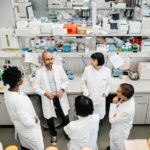By Colorado State University
Increasing the diversity of scientists is a priority for many universities and professional societies. Diverse teams are more productive and innovative, and more fully represent the human race by including ideas from different segments of the population.
But major disparities in gender, ethnicity and other aspects of a diverse workforce persist in various science, technology, engineering and math (STEM) fields at universities.
To learn more about these disparities, a team of researchers led by Colorado State University graduate student Miguel Jimenez and postdoctoral fellow Theresa Laverty surveyed 469 faculty members from ecology and evolutionary biology programs at universities across the United States.

They found that while most people who responded to the survey reported engaging in diversity and inclusion activities, those who participated in these activities at the highest levels were more likely to identify themselves as non-white, non-male or the first generation in their family to attend college.
The research team also found that this type of engagement was not perceived as being important for obtaining tenure and that faculty identified time and funding as major limitations to take part in diversity and inclusion activities.
Based on the findings, the scientists recommend that institutions dedicate or reallocate more resources for diversity and inclusion activities and reconsider how faculty are evaluated to ensure shared responsibility.
The study was published June 3 in Nature Ecology & Evolution.
Theresa Laverty, one of the study’s lead authors and a postdoctoral fellow in the Department of Fish, Wildlife and Conservation Biology at CSU, said the findings are a great first step in finding ways to encourage more faculty to take part in diversity and inclusion activities on college campuses.
Liba Pejchar, associate professor in the Department of Fish, Wildlife and Conservation Biology and a study co-author, said the research resonated with scientists in her lab, which includes Jimenez, who is pursuing a graduate degree in ecology at CSU.
“A lot of people in our group, who come from diverse backgrounds, and others have talked about being recruited to an institution and the reasons why they didn’t feel welcome there,” she said. “Faculty can play a big role in the way that universities promote inclusion. They can also help identify the ways that people are participating in these activities.”
Pejchar said the team was interested in determining who on college campuses is taking responsibility for making change happen in diversity and inclusion.
“We wanted to know what the level of engagement is, along with challenges and opportunities,” she said.
Jimenez said he hopes the findings will eventually lead to ecology becoming a more effective field.
“It helps when a field of study represents the community it is serving,” he explained. “The more relatable a team is, that helps serve the general public better. Diverse groups are more productive and better at problem-solving, so there are lots of benefits to this approach.”
Laverty said having more diversity on a team also helps a wide variety of people see a career in ecology or conservation as something that is attainable.
“It’s a nice confidence booster for students of diverse backgrounds,” she said.
This article was previously posted on phys.org.
More information: Underrepresented faculty play a disproportionate role in advancing diversity and inclusion, Nature Ecology & Evolution (2019). DOI: 10.1038/s41559-019-0911-5 , https://www.nature.com/articles/s41559-019-0911-5












